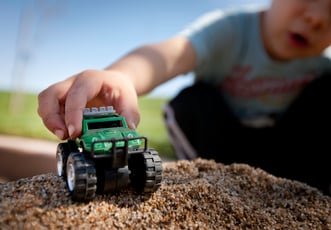How To Use Shaping to Teach Autistic Children New Behaviors at Home
As children become older and begin to develop new skills, it can be overwhelming for caregivers and parents to teach more complex behaviors, such as developing new language, making requests, cleaning their room, or completing homework. When caring for a child diagnosed as autistic, teaching these complex behaviors can seem almost impossible. In applied behavior analysis (ABA), we use a simple procedure called shaping, which teaches a new skill one small step at a time. Each step is reinforced before a new step is taught. Learning a new behavior or skill step-by-step allows autistic children to master more complex tasks.
Using Shaping to Develop New Behaviors
When shaping a behavior, the child begins by approximating a goal or “taking baby steps.” As the child gets better at each step, you raise the bar little by little. This cycle is repeated until the learner masters the end goal. Think of shaping as a step-by-step, gradual learning process. For example, in a child with limited verbal skills, you may want to teach the child to request an item by its name. If the child loves to play with a toy truck, you may use this interest to teach the child how to request the toy by saying “truck.”

How to Begin Using Shaping
Begin by teaching the child the first sound in the word truck /t/. Each time the child makes the /t/ sound, roll the truck to the child and offer verbal praise. Be sure to offer verbal praise enthusiastically each time. If the child vocalizes any other letter that is not /t/, do not roll the child the truck, and start over. Once the child masters the letter /t/ sound, make the next step more difficult by adding the /r/ sound. Now the child must vocalize /tr/ before you roll the truck and offer praise. Each time the child masters a new sound add another letter or letter sound to the word, such as /t/, /tr/, /tru/, /truck/.
Important Tips About Using Shaping
Here are a few important tips that may help you use the process of shaping a behavior more effectively:
- In this example, by only rolling the child the truck when the child pronounces the correct sound, you are reinforcing successive approximations of the word “truck.” The child is getting closer and closer to vocalizing the entire word.
- To take the pressure away and avoid overwhelming yourself or the child, use this process over time, such as learning a new sound each day.
- Once you move to the next step, do not reinforce the previous step any longer; if the child already mastered /t/ and /tr/, you no longer offer reinforcement for the vocalization of those sounds because you already moved on to /tru/.
 Make sure you are only using one specific object, such as the favorite toy truck, and the child does not have access to any other toy trucks while working on the skill. If the child has multiple toy trucks within reach, there is less of a chance the child will engage with you.
Make sure you are only using one specific object, such as the favorite toy truck, and the child does not have access to any other toy trucks while working on the skill. If the child has multiple toy trucks within reach, there is less of a chance the child will engage with you.- You may also want to put the toy truck or the reinforcement out of reach throughout shaping the entire behavior and only allow access when specifically working on this skill. This makes the toy truck a more powerful reinforcer.
Using Shaping for Everyday Tasks at Home
When telling your child to clean their room, it is not likely the child will be successful if they never cleaned their room before. Instead of expecting the child to make their bed, clean up their toys, and put their pajamas in the laundry bin perfectly the first time, you would teach one step at a time and possibly break down each of these steps into “approximations” or even simpler tasks. You may start by simply having the child pull their blankets up on the bed each day and offering reinforcement. Once the child masters that simpler task, you may show them how to neatly pull up the sheets and the comforter.
Next week, once the child has mastered making the bed, you may start having the child make the bed and pick up the toys. If the child has toys and a bookshelf in their room, you may break it down further by teaching the child how to clean up the toys and then adding in how to put the books back on the bookshelf.
 Once each of these tasks is mastered, you teach the child how to put their pajamas in the laundry bin. Each time the child masters a new step you offer reinforcement, such as verbal praise, a sticker, or access to a favorite toy or activity. Make sure each new task builds on the last task. For example, the child should make the bed AND pick up the toys to receive the reinforcement. Be sure to model each task for the child as you teach them. You would not know how to make a bed if no one ever showed you before!
Once each of these tasks is mastered, you teach the child how to put their pajamas in the laundry bin. Each time the child masters a new step you offer reinforcement, such as verbal praise, a sticker, or access to a favorite toy or activity. Make sure each new task builds on the last task. For example, the child should make the bed AND pick up the toys to receive the reinforcement. Be sure to model each task for the child as you teach them. You would not know how to make a bed if no one ever showed you before!
Over time, the child will be able to clean their entire room on their own. As the child grows, you can add in new tasks, such as vacuuming, changing the sheets, etc.
Using Picture Charts
When using shaping to teach an autistic child a new skill, using a picture chart, picture cards, or a picture wheel can be extremely beneficial. A picture chart may be helpful for children who struggle to complete all of the steps or transition from one step to another. The child can look at the chart and know exactly what to do and what will come next. A picture wheel may add an element of fun to a task for those children who thrive with making activities or tasks into a game. Picture cards are helpful for children who do best with instant reinforcement. Completing a step and producing a card to show it is completed provides self-reinforcement.
The Theory of Shaping
The theory of shaping is that by reinforcing successive approximations (baby steps) that are closer and closer to the desired behavior, the child will build the confidence and understanding necessary to complete a more complex task and master the desired behavior. These processes take time!
Please let us know your experiences with using shaping. What worked for you?

Marianne Coppola
Marianne Coppola, MHA, ABA works as a child development specialist with toddlers and pre-schoolers. She is passionate about early intervention and finding creative and engaging ways to help children reach developmental milestones. Her work extends to children diagnosed with Autism Spectrum Disorder, Attention Deficit Hyperactivity Disorder, Sensory Processing Disorder, Social Anxiety, and Motor Development Delays. She holds an M.A. in Healthcare Administration, and an M.A. in Special Education and Applied Behavior Analysis. She is currently studying to become a Board-Certified Behavior Analyst and is pursuing a PhD in Behavioral Health.




